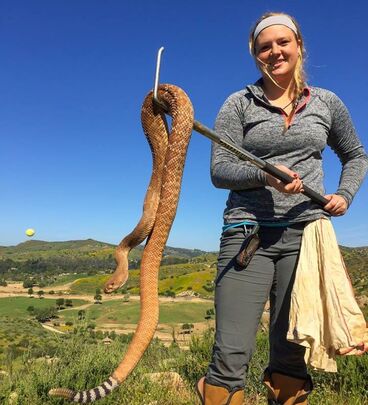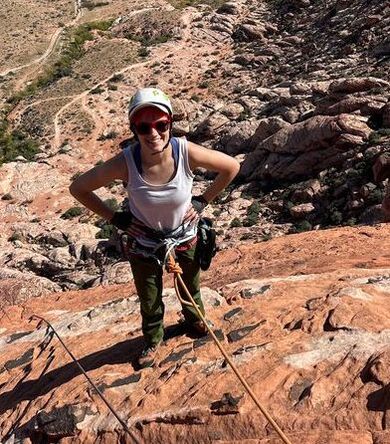Principle Investigator
|
Chris R. Feldman (Lab Overlord)
My research interests are broad, and past or present projects include applied ecological work on local reptiles facing anthropogenic change, to more basic evolutionary work, such as examining population genetic structure to estimate connectivity and adaptive potential, understanding speciation and isolating mechanisms, assessing biogeographic “rules” in vertebrates, examining patterns of morphological and molecular evolution and their underlying causes. A major part of my research program focuses on the coevolution between toxic newts (Taricha) and their resistant garter snake predators (Thamnophis). Together with wonderful collaborators, we have been examining several aspects of this system, from behavioral ecology, to physiology, to constraints on molecular evolution. |
Graduate Students
|
Kelly Robinson (Doctorate)
Broadly, I am interested in the mechanistic underpinnings and behaviors of coevolutionary relationships between predators and prey. My current research focuses on the relationships between toxins and toxin resistance among herpetofauna. As well as trying to understand any physiological tradeoffs to maintaining and/or producing toxins and toxin resistant components. |
|
Sage Babish (Masters)
I am broadly interested in the evolution of specialized traits and their distribution both across and within species, and I seek to understand how the distribution of these traits is shaped by ecosystem characteristics and interspecific interactions. I study how specialization evolves and is maintained or lost in a population using phylogenetics and genomic methods. My current research focuses on the genetic underpinnings of TTX resistance in garter snakes (Thamnophis) and how causal loci assort between populations of snakes sympatric and allopatric with their toxic prey, Taricha newts. Previous research has focused on the phylogenetic distributions of specialized traits in toads and turtles, and the correlations between the distributions of those traits and species' habitats and life histories. |
Undergraduate Students
Sanjeev Wagner (Undergraduate Research)
Sanjeev has been helping Kelly quantify coloration and color patterns in multiple garter snake species engaged with toxic newts. Resistant garter snakes may contain substantial amounts of newt toxins, and thus be poisonous to their own predators. The project will determine the potential correlation between snake resistance to TTX, and snake colors and patterns (i.e. potential warning signals).
Sanjeev has been helping Kelly quantify coloration and color patterns in multiple garter snake species engaged with toxic newts. Resistant garter snakes may contain substantial amounts of newt toxins, and thus be poisonous to their own predators. The project will determine the potential correlation between snake resistance to TTX, and snake colors and patterns (i.e. potential warning signals).
Dearly Departed (former lab members)
Graduate Students
Haley Moniz, PhD
Haley examined the potential "costs" of adaptive TTX-resistance in resistant garter snake predators (Thamnophis), first focusing on physiological (energetic) costs and then focusing on performance costs. In addition, she examined antipredator traits in newts (Taricha), showing that newt colors are visible to a wide range of potential predators.
Joshua Hallas, PhD (co-advised with Tom Parchman)
Josh used phylogenomic and population genomic techniques to understand how environmental variation, biogeographic history, and natural history influenced patterns of population structure, local adaptation, and genetic differentiation in garter snakes (Thamnophis atratus, Th. elegans, and Th. couchii).
Robert Del Carlo, PhD (co-advised with Norm Leblanc)
Robert's work examined the biophysical constraints on evolution and the reconstruction of evolutionary paths. His research used advanced techniques in biochemistry, molecular biology, and biophysics to assess the performance of garter snake muscle and sodium channels (Nav1.4) for tradeoffs to toxin-resistance.
Jessica Reimche, PhD (co-advised with Karen Schlauch)
Jessica's research combined ecological, physiological, and genomic data to answer questions about adaptive evolution. Her dissertation focused on understanding the genetic mechanisms contributing to adaptive toxin-resistance in the Sierra garter snake (Thamnophis couchii). She quantified geographic variation in TTX-resistance in skeletal muscle tissue, resistance gene expression, and characterized functional variation in three candidate loci using RNA-seq analyses.
Erica Ely (Graduate Research)
Erica's research focused on the interactions between species and their habitats, and how those interactions can vary geographically and temporally. She used museum collections and conducted field work to study the feeding habits of garter snakes (Thamnophis) in the Sierra Nevada and Lower Cascade Mountain Ranges in California.
Vicki Thill, MSc (co-advised with Mike Teglas)
Vicki's research involved predator-prey interactions between reptiles and their potentially dangerous arthropod prey. Specifically, she investigated whether various lizards of the southwestern US (Elgaria multicarinata, Sceloporus occidentalis, Uta stansburiana, etc.) might be resistant (or susceptible) to the potent venom of the western black widow spider (Latrodectus hesperus). She was also very active in museum curation, and served as curatorial assistant for the UNR Museum of Natural History for vertebrate collections (mammals, reptiles, fish, and birds) for much of her graduate stay at UNR.
Gareth Blakemore, MSc
Gareth's thesis work focused on Cheatgrass (Bromus tectorum) invasion of the Great Basin Desert. Cheatgrass has been implicated in reductions of species abundance and diversity for a variety of taxa, yet little is known in terms of impacts on reptile communities or the mechanisms that drive these declines. To better understand the local and landscape scale implications of cheatgrass invasion on reptiles, Gareth's work approached (1) quantifying reductions in abundance and richness of reptiles in cheatgrass habitats versus shrub habitats, (2) investigating mechanisms by which B. tectorum reduces habitat suitability for reptiles at the local scale (altered habitat structure, prey base and loss of thermal microhabitats), and (3) scaling up local findings to infer landscape patterns of reptile demography. Gareth defended his work to a full house in Summer of 2018.
Jade Keehn, MSc
Jade's Master's thesis investigated the effects of wind energy developments on local desert communities at several levels, from changes plant, arthropod, and terrestrial vertebrate communities, to demographic fluctuations in lizard populations, down to fine-scale changes in behavior and physiology of individual lizards.
Scott Appleby, MSc
Scott investigated the effects of fuel reductions on small mammal communities in the Lake Tahoe Basin and examined the relative impacts of various fuel reduction methods which might better inform future forest practices.
Undergraduate Students
Sage Kruleski (Undergraduate EPSCOR Scholar)
Sage investigated the potential correlation between newt toxin levels (TTX) and aspects of dorsal and ventral coloration, brightness, and contrast that signal "danger" to would-be predators.
Janna Magana (Undergraduate Thesis)
Janna's thesis project investigates the role of temperature influencing skeletal muscle performance across various garter snake species and from various locations along the West Coast.
Arielle Navarro (Honors Undergraduate Thesis)
Arielle's Biology Honors thesis project investigated the comparative physiology of muscles from snakes with various feeding strategies.
McKenzie Wasley (Postgraduate Research Assistant)
Kenzie graduated from UNR with a bachelor's degree in Wildlife Ecology and Conservation. In preparation for pursuing her M.S., she assisted with a variety of projects in the lab. Her help was invaluable, especially in assisting Vicki's work on lizard resistance to black widow spider venom and Haley's work on quantifying performance in garter snakes. She spent her free time working as a veterinary assistant and in Fall 2020, graduated from the Mullin Lab at Stephen F. Austin State University with her M.S.
Kristina Bozanich (Honors Undergraduate Thesis)
Kristina investigated the potential impact of invasive cheatgrass (Bromus tectorum) on small reptiles in the Great Basin. She specifically examined if and how cheatgrass influences the diversity and abundance of local reptiles in northern Nevada.
Melanie Frinke-Craig (Honors Undergraduate Thesis)
Melanie investigated the relationship between plumage coloration and diet and body condition in local Lesser Goldfinches to determine whether urban and suburban birds differ in ecology and morphology from birds in natural habitats.
Jade Keehn (Honors Undergraduate Thesis)
Jade's honors undergraduate thesis examined morphological divergence between reptile populations on Anaho Island in Pyramid Lake (~35 miles NE of Reno) and populations on the adjacent mainland to assess trends in patterns of body size evolution on this small Great Basin Desert island.
Christina New (Postgraduate Research)
Christina studied the feeding behaviors of two morphologically similar snakes that occupy distinct ecological communities. She conducted a series of prey preference and diet trials on a captive colony of two species of sharp-tailed snakes (Contia tenuis and C. longicaudae) in the lab.
Haley Moniz, PhD
Haley examined the potential "costs" of adaptive TTX-resistance in resistant garter snake predators (Thamnophis), first focusing on physiological (energetic) costs and then focusing on performance costs. In addition, she examined antipredator traits in newts (Taricha), showing that newt colors are visible to a wide range of potential predators.
Joshua Hallas, PhD (co-advised with Tom Parchman)
Josh used phylogenomic and population genomic techniques to understand how environmental variation, biogeographic history, and natural history influenced patterns of population structure, local adaptation, and genetic differentiation in garter snakes (Thamnophis atratus, Th. elegans, and Th. couchii).
Robert Del Carlo, PhD (co-advised with Norm Leblanc)
Robert's work examined the biophysical constraints on evolution and the reconstruction of evolutionary paths. His research used advanced techniques in biochemistry, molecular biology, and biophysics to assess the performance of garter snake muscle and sodium channels (Nav1.4) for tradeoffs to toxin-resistance.
Jessica Reimche, PhD (co-advised with Karen Schlauch)
Jessica's research combined ecological, physiological, and genomic data to answer questions about adaptive evolution. Her dissertation focused on understanding the genetic mechanisms contributing to adaptive toxin-resistance in the Sierra garter snake (Thamnophis couchii). She quantified geographic variation in TTX-resistance in skeletal muscle tissue, resistance gene expression, and characterized functional variation in three candidate loci using RNA-seq analyses.
Erica Ely (Graduate Research)
Erica's research focused on the interactions between species and their habitats, and how those interactions can vary geographically and temporally. She used museum collections and conducted field work to study the feeding habits of garter snakes (Thamnophis) in the Sierra Nevada and Lower Cascade Mountain Ranges in California.
Vicki Thill, MSc (co-advised with Mike Teglas)
Vicki's research involved predator-prey interactions between reptiles and their potentially dangerous arthropod prey. Specifically, she investigated whether various lizards of the southwestern US (Elgaria multicarinata, Sceloporus occidentalis, Uta stansburiana, etc.) might be resistant (or susceptible) to the potent venom of the western black widow spider (Latrodectus hesperus). She was also very active in museum curation, and served as curatorial assistant for the UNR Museum of Natural History for vertebrate collections (mammals, reptiles, fish, and birds) for much of her graduate stay at UNR.
Gareth Blakemore, MSc
Gareth's thesis work focused on Cheatgrass (Bromus tectorum) invasion of the Great Basin Desert. Cheatgrass has been implicated in reductions of species abundance and diversity for a variety of taxa, yet little is known in terms of impacts on reptile communities or the mechanisms that drive these declines. To better understand the local and landscape scale implications of cheatgrass invasion on reptiles, Gareth's work approached (1) quantifying reductions in abundance and richness of reptiles in cheatgrass habitats versus shrub habitats, (2) investigating mechanisms by which B. tectorum reduces habitat suitability for reptiles at the local scale (altered habitat structure, prey base and loss of thermal microhabitats), and (3) scaling up local findings to infer landscape patterns of reptile demography. Gareth defended his work to a full house in Summer of 2018.
Jade Keehn, MSc
Jade's Master's thesis investigated the effects of wind energy developments on local desert communities at several levels, from changes plant, arthropod, and terrestrial vertebrate communities, to demographic fluctuations in lizard populations, down to fine-scale changes in behavior and physiology of individual lizards.
Scott Appleby, MSc
Scott investigated the effects of fuel reductions on small mammal communities in the Lake Tahoe Basin and examined the relative impacts of various fuel reduction methods which might better inform future forest practices.
Undergraduate Students
Sage Kruleski (Undergraduate EPSCOR Scholar)
Sage investigated the potential correlation between newt toxin levels (TTX) and aspects of dorsal and ventral coloration, brightness, and contrast that signal "danger" to would-be predators.
Janna Magana (Undergraduate Thesis)
Janna's thesis project investigates the role of temperature influencing skeletal muscle performance across various garter snake species and from various locations along the West Coast.
Arielle Navarro (Honors Undergraduate Thesis)
Arielle's Biology Honors thesis project investigated the comparative physiology of muscles from snakes with various feeding strategies.
McKenzie Wasley (Postgraduate Research Assistant)
Kenzie graduated from UNR with a bachelor's degree in Wildlife Ecology and Conservation. In preparation for pursuing her M.S., she assisted with a variety of projects in the lab. Her help was invaluable, especially in assisting Vicki's work on lizard resistance to black widow spider venom and Haley's work on quantifying performance in garter snakes. She spent her free time working as a veterinary assistant and in Fall 2020, graduated from the Mullin Lab at Stephen F. Austin State University with her M.S.
Kristina Bozanich (Honors Undergraduate Thesis)
Kristina investigated the potential impact of invasive cheatgrass (Bromus tectorum) on small reptiles in the Great Basin. She specifically examined if and how cheatgrass influences the diversity and abundance of local reptiles in northern Nevada.
Melanie Frinke-Craig (Honors Undergraduate Thesis)
Melanie investigated the relationship between plumage coloration and diet and body condition in local Lesser Goldfinches to determine whether urban and suburban birds differ in ecology and morphology from birds in natural habitats.
Jade Keehn (Honors Undergraduate Thesis)
Jade's honors undergraduate thesis examined morphological divergence between reptile populations on Anaho Island in Pyramid Lake (~35 miles NE of Reno) and populations on the adjacent mainland to assess trends in patterns of body size evolution on this small Great Basin Desert island.
Christina New (Postgraduate Research)
Christina studied the feeding behaviors of two morphologically similar snakes that occupy distinct ecological communities. She conducted a series of prey preference and diet trials on a captive colony of two species of sharp-tailed snakes (Contia tenuis and C. longicaudae) in the lab.
Prospective Students
Interested in graduate work in the Feldman Lab? Feel free to reach out to me and my students about graduate research in the lab, and life in EECB, UNR and Reno.
Successful applicants have:
Successful applicants have:
- read several representative papers from the lab
- overlapping research interests with the lab
- a good sense of the kind of work they want to conduct or topics they want to address
- passion for biology (and science)
- strong work ethic, determination, drive, grit



